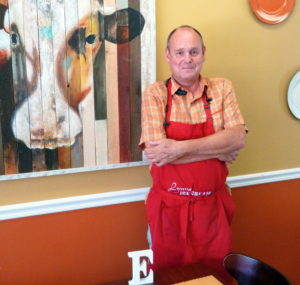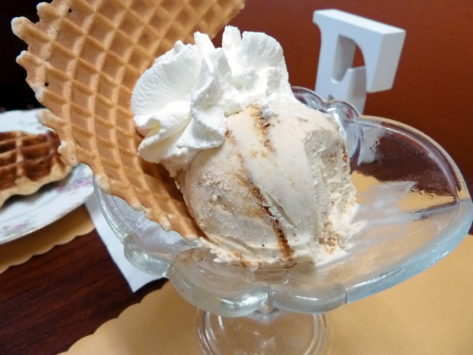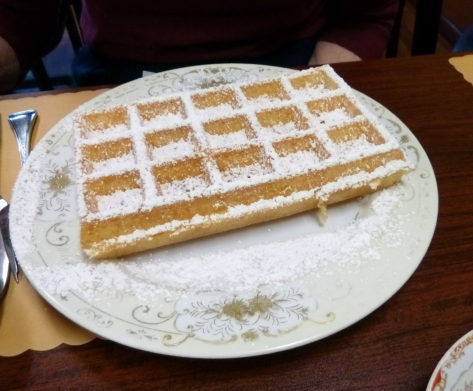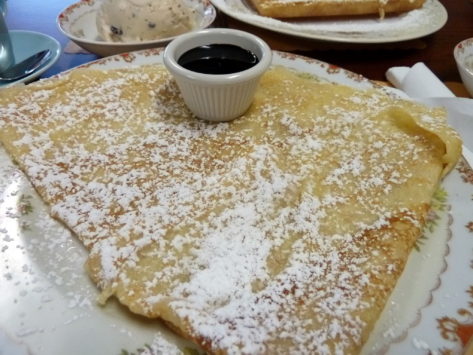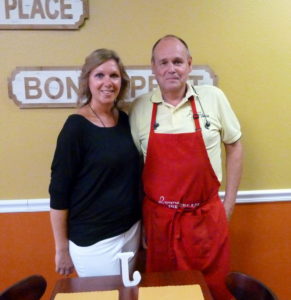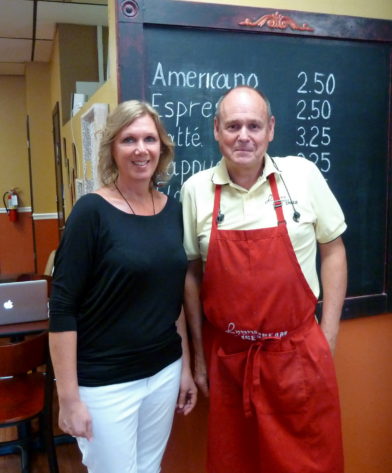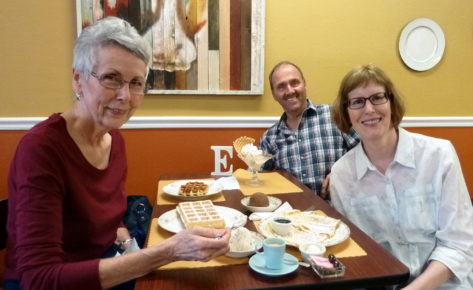Lynn’s Ice Cream and Belgian Waffles
Yesterday, I arrived in Inverness, Florida. I’m here to visit my mother and Gary. One of the first things we’ll do, as soon as I’ve published this posting, is to head over to a nondescript strip mall on Highway 44 West where one of the most unique ice cream establishments in America is found: Lynn’s Ice Cream & Belgian Waffles.
During a previous trip to Inverness, I spent several hours with the owners, Lynn and Rudi Weber, they answering my many questions so that I could write something about them for this blog. It’s amazing what the reward of eating some very good ice cream, waffles, and crêpes, and visiting with two very likeable Belgians, will do for writer’s block.
The First Scoop
Lynn and Rudi sell their ice cream not only from their location on Highway 44 but also from a truck at special events around the state of Florida (and sometimes beyond). The latter was how I first sampled their ice cream—at the annual “People’s Choice” Food Competition held in downtown Inverness along the lake in April.
It was the tail end of the event, and only stragglers remained: the ones happy on beer who weren’t quite ready for the fun to end, and us, looking for an ice cream fix. Mom, Gary, and I were the last customers of the evening at the ice cream truck emblazoned with a sign that read “Lynn’s Real Homemade Ice Cream & Belgian Waffles.” The man with the foreign accent who filled our cones came out from the truck to stretch his legs and chat.
I could hardly contain myself, just couldn’t wait to tell him what I thought of his vanilla ice cream—the gold standard, the true test of quality behind which no faults can hide. His vanilla ice cream wasn’t too sweet—had no cloying or odd aftertaste—and had plenty of the heady flavor you only get from pure vanilla. The texture was perfect, too: creamy and dense yet not hard, nearly the consistency of a gelato.
“This vanilla ice cream is very good,” I gushed, as he approached us. He smiled a big smile.
“I use Bourbon vanilla seeds and pure vanilla extract. It’s the most expensive flavor I make.”
His comment struck me as ironic considering a lot of people overlook vanilla ice cream, think of it as a nothing flavor, not worth considering; it also reminded me of news I’d heard about there being a vanilla shortage, and that prices would increase dramatically,
My mom and Gary complimented him on the flavor both of them had chosen—butter pecan. He said he was glad they liked it, and then let us in on a secret. “What makes that a really good butter pecan are the pecans. They aren’t ordinary pecans. They’re gourmet roasted and caramelized pecans that I special order.”
The Second Scoop
Standing outside of the ice cream truck, Rudi Weber had said a few things about doing business in the U.S. that intrigued me, and I wanted to hear more. A few days later, my mom and I visited his brick-and-mortar venue so that I could interview him. We had the place to ourselves; he had us over on the day of the week when he typically makes ice cream, when the shop is closed.
It’s at the shop where you get a sense of Rudi’s creativity. In the truck, due to size limitations, he can offer only six flavors. At the shop, he has about 25 rotating flavors on offer, many unique. But the total number he’s developed so far is more than fifty.
When we walked in, he was finishing up a batch of ice cream. He showed me the fresh ice cream mix he uses, delivered weekly from St. Petersburg–based Dairy-Mix, Inc., and the all-natural flavoring and other high-quality ingredients he was using to make the day’s flavor. I felt a flash of disappointment, or was it the bruising of my ego: Do I have lousy taste buds? Not refined enough to tell the difference between with an ice cream made entirely from scratch and one made with a premade base? I long for the from-scratch version of everything in life, but I’m forced to acknowledge this: just because something is premade, doesn’t mean it’s necessarily of inferior quality.
Since the invention of ice cream, professionals today have a lot of short-cuts available to them, and premade fresh ice cream mix is one of them. Rudi takes advantage of this short-cut, without sacrificing flavor, letting someone else make the base so that he can focus on being the flavor-meister that he is, and to better manage, with the help of his wife, Lynn, all of the other details of running a business. Lynn’s domain is making the homemade cones as well as the dough and batter for the waffles and crêpes and cooking them when orders come in, as well as running the entire shop when Rudi is out at an event with the truck.
The Big Scoop: It’s Much More than an Ice Cream “Shop”
Lynn and Rudi are from Antwerp, and it’s their Belgian roots that makes their establishment so special. First off is the concept of the place: It’s modeled after a European café where you might linger over a sweet treat in the company of others and cap it all off with a small cup of bracing, roast-y espresso.
Other differences: The ice cream is not stored in or scooped from a display case while you stand by; Rudi says the open air of a dipping counter promotes the formation of ice crystals. Instead, your order is taken at the counter, sent on a ticket to the kitchen, where it is prepared, and brought to your table on glass or ceramic dishware—no paper or plastic here. Ice cream cones are presented in an elegant stand.
Besides this being an entirely civilized way to enjoy a serving of ice cream, you avoid the always awkward money-for-ice-cream exchange at ice cream counters that nobody has enough hands for.
The other way that Lynn’s Ice Cream and Belgian Waffles is not like a typical ice cream shop is the Weber’s policy on ice cream samples: there are none, or nearly none. Rudi told me that originally, they offered samples but in time saw too many people abusing the spirit of the free taste, trying ten flavors and then walking out, without deciding on one and making a purchase. After you’ve placed your order, however, they will happily bring you a generous sample size of that second flavor you were waffling on.
The Belgian touch can be seen throughout: in specific ice cream flavors, notably Black Licorice and Belgian Cookie (made with Lotus Biscoff Cookies); in the ingredients used (for example, for their chocolate flavor, they use Callebaut chocolate, a Belgian brand); and of course, in the homemade waffles and crêpes, made using traditional recipes and ingredients.
If you want to know what a good Belgian waffle is outside of Belgium, have a Belgian cook make one for you. Lynn makes two types, the Liège and the Brussels, each made in its own type of waffle iron. The latter is the type most familiar to Americans, what we call a “Belgian” waffle. Except that the Webers’ version—with its pale golden color and incredibly delicate texture and good flavor (thanks to the fresh yeast used in the dough)—far exceeds any Belgian waffle I’ve had in the States. When dusted with powdered sugar, de rigueur in Belgium, and perhaps topped with a dollop of whipped cream, popular in Belgium, eating the Brussels is like eating an éclair or some other fine pastry with an airy interior and lightly crispy exterior. (A photo of the Brussels waffle on Rudi and Lynn’s site shows its airiness far better than my snapshot quality photos [click here to see what I mean]).
The Liège waffle is the dense cousin of the feather-light Brussels; I have to say I prefer its satisfyingly chewy texture and well browned exterior. It is made with a special ingredient: Belgian Pearl sugar, small balls of sugar that are mixed right into the dough and caramelize and sweeten the waffle from the inside out. No need to dust powdered sugar on this one. It’s perfect as is. On their site, Lynn and Rudi saythat the Liege waffle “can make the world feel right again on the dreariest of days.” I agree.
And the crêpes? They are crêperfect: thin, flavorful, and lightly sweetened and flavored with Belgian vanilla sugar. They are made on a crêpe plate, the traditional way. You can top the crêpes with American pancake syrup if you like, but I’d go for a drizzle of the much more interesting Belgian candy syrup called Candico. It very dark and thick and much less sweet than it sounds: the taste is a balance of sweet and bitter, making molasses the best comparison, but that’s not quite right; it’s subtler than that and has a taste all its own.
Naturally, the menu board also reflects Rudi and Lynn’s current home, 4,500 miles from their old one. Aside from the Belgian-focused flavors, the other ice cream flavors can be divided in three basic categories: the standard classics that everyone wants, such as vanilla, chocolate, strawberry, coffee, and so on; the old-fashioned flavors, such as butter pecan, maple walnut, candy cane, orange pineapple (many of these Rudi developed in response to requests from their older clientele); and the original “Rudi”-inspired flavors. These are clearly the work of a mad man mixologist. Many feature the use of liqueurs and liquors, like amaretto, Grand Marnier, Irish cream, Kahlúa, limoncello, rum. There is even a beer-flavored ice cream (Guinness). He adds plenty of touches to take his flavors from ordinary to extraordinary: For the Limoncello flavor, he uses his own house-made limoncello; for the Grand Marnier flavor, in addition to the liqueur, he uses fresh orange zest and juice; for the Rum and Raisins flavor, he soaks the raisins in Myers’s rum and then purees some of the raisins and adds that to the ice cream base, along with the whole raisins, to make sure customers get the flavor of the rum-soaked raisins throughout, in each and every bite.
Rudi’s process is that of a passionate ice cream zealot (an attribute I personally like to see in my local ice cream entrepreneur). Each new ice cream flavor undergoes lots and lots of trial runs, long before the public gets to taste it. Then, once Rudi is satisfied with it, he will take it out for a test drive, offering tastes to his regular customers. He will tweak it further based on their feedback, and then once again have his customers do taste tests. He does this until everyone feels the flavor is perfect. If just one person doesn’t like it, the flavor goes back to his test kitchen.
To get the full experience at Lynn’s Ice Cream, and to meet Lynn, the waffle- and crêpe-maker, we returned later in the week during regular business hours. I wanted to hear more from Lynn and Rudi about a particular challenge they are facing, one that no American-born ice cream entrepreneur would need to contend with.
Migrant Entrepreneurs
“Doing business is paradise here,” said Rudi. Here being the United States. He ought to know. Before coming to the States, Rudi already had 30-odd-years’experience working for himself, running various types of businesses back in Belgium, including restaurants.
Rudi found it difficult, as a small entrepreneur, to run a profitable business in Belgium. “The labor laws and taxation are crippling business owners,” he said. “It’s unsustainable.”
In search of a better climate for doing business, and sunshine (Belgium can be very gray in the winter, Lynn added), Rudi and Lynn came to the Florida at the beginning of 2013 on an E-2 Investor Visa. Their first visa was for good for five years. In December of last year, Rudi traveled back to Belgium to apply for a renewal, while Lynn stayed back to run the business. They assumed they would be granted another five-year visa. They had proven themselves: they’d opened a successful business, bought a home, employed Americans, and had been true to the promise that all E-2 visa holder must make—to not take advantage of charity of any kind. But they were given just a one-year renewal, too short a time to make any real plans for the business. Since then, they are in a waiting game, and feel their lives, and their plans for the business, are on hold.
Rudi and Lynn chalk up the change between 2013 and 2017 to the Trump administration’s much stricter immigration policies. They appreciate the need for border controls (they feel that is one of the issues that the European Union, with its open borders policy, has not got right), but only if implemented logically and on a case by case basis. They don’t understand why they are not being encouraged to stay: they pay taxes, they buy supplies for their business from other American business, they are law abiding. If at the end of this year they are granted another one-year visa, instead of the five-year visa they’re requesting, they say they may feel the need to leave the U.S. and start a business elsewhere, where they are welcomed. (Though they would not return to Belgium, they added.)
If they do leave the U.S. on account of the current administration’s immigration policy, that would be a real shame. I would miss their ice cream and waffles and dropping by for a visit when I’m in town. I know exactly what I’ll title my follow-up story: “Is ICE Freezing Out Ice Cream Makers?”
* * * * * * * * * * * * * * * * * * * * * * * * * * * * * * * *


